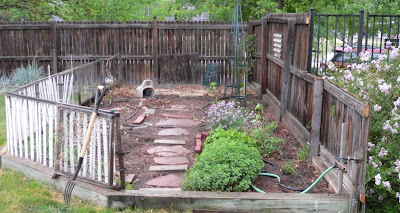While I've long had a general appreciation for honeybees, I didn't know much about them except the general things most people know: they're good for the garden and crops; they're clever engineers; they make something good to eat!

I started to get more interested last year after reading Douglas Whynott's (ain't that a great name?) "Following the Bloom: Across America With the Migratory Beekeepers." As it turns out, I reviewed it exactly a year ago today! (
My review is here.)
About a month after that, I saw
my first wild beehive, in a tree that had blown down in a storm. I started noticing bees around me more, and wondered where their hives were. Still just in a vague sort of way.
In the last couple of weeks, though, my sighting of three different swarms within blocks of each other pushed my interest up several notches. Where do bees live? All around me! These urban bees are not keeping house in a row of tidy white boxes watched over by a beekeeper but in countless hollowed-out trees and likely an attic or two.
And quite possibly, as I've discovered, in a backyard beehouse discreetly harbored by a bee-loving neighbor. I don't know this for sure, but if there are people quietly keeping chickens in my 'hood (and I know there are), surely there are some beekeepers too.
After I saw that first swarm, I started researching in earnest, and ran across Boulder-based
BackYardHive.com. The site has a wealth of information for urban beekeepers and answered a lot of questions I had.

The site also introduced me to the
top-bar hive. This kind of hive has been used by beekeepers for thousands of years and is common in Africa. It is not as efficient for honey production as the more recent and popular box-type hives (called the Langstroth system), but is easier to maintain and possibly healthier for the bees.
Isn't it attractive? One of the things that has kept me from thinking I could keep bees in my yard is the very obvious nature of the white, traditional beebox. If just one nosy and ignorant neighbor spotted it and freaked out, I'd probably have to get rid of it. Never mind that honeybees are not aggressive and are good for our gardens. They are not at all like wasps or hornets.
But this hive is both attractive and discreet. It doesn't scream out "BEEEEEEES! BEES LIVE HERE!" Should it be spotted through a gap in the fence, I doubt the casual passer-by would recognize what it is. And the supposed ease of maintaining it (plus the nifty viewing window in the side) has tipped me over from "I wish I could keep bees" to "How soon can I keep bees?"

I could buy a box from the site, but they're quite expensive. Happily, they offer the plans, too, so Pascal is going to see if he can build one. I can order just the top bars, which appear to be the most critical element to get exactly right.
I doubt I will get bees this year, but I am planning on it for next spring. I will likely take a class from the Backyardhive folks, and then watch for a swarm to capture. The lady who who had two this year has my number!
To see all the posts about my bee encounters,
click here.
 Spring has come. Neighbor said, "One chicken we lost to a raccoon, another to old age, and the third has stopped laying. We got another hen who turned out to be a rooster, and we haven't gotten around to adding any more. So no eggs, sorry."
Spring has come. Neighbor said, "One chicken we lost to a raccoon, another to old age, and the third has stopped laying. We got another hen who turned out to be a rooster, and we haven't gotten around to adding any more. So no eggs, sorry." Elvis the rooster (that's Squeaky the non-laying hen behind him) may be sent to a farm, as he cockle-doodle-doos all day long. The neighbors all like him, his guardian says, and she's grown fond of his clownish ways (which include standing atop that ball and rolling it). But I'll bet there are a few neighbors who don't.
Elvis the rooster (that's Squeaky the non-laying hen behind him) may be sent to a farm, as he cockle-doodle-doos all day long. The neighbors all like him, his guardian says, and she's grown fond of his clownish ways (which include standing atop that ball and rolling it). But I'll bet there are a few neighbors who don't.















































